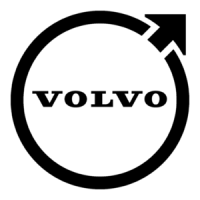Volvo Trucks North America, Inc. Date Group No. Page
Service Bulletin 4.2004 392 08 39(47)
Speakers
All speakers operate on the same basic principle. A basic
speaker consists of a cone, voice coil, magnet, magnetic
core and two wires which connect the speaker to the
receiver.
The speaker’s permanent magnet creates a magnetic field
that is radiated outward and through the voice coil that
is attached to the cone. As the audio signal (alternating
current) passes through the voice coil, it creates a varying
magnetic field that interacts with the magnetic field from
the permanent magnet. This interaction of magnetic fields
forces the cone to move back and forth, thus creating
sound waves.
The speaker plus (+) and minus (-) (or A and B) signs
only define a direction of motion during the conversion
from electrical to mechanical energy.
The plus and minus do not directly relate to a voltage
level. By convention, if a battery‘s positive terminal is
connected to speaker terminal (+) and battery negative
is connected to speaker terminal (-) then the speaker
cone will move outward. Speakers should be connected
with the correct polarity to the receiver, otherwise the
two different speaker cones can be moving in opposite
directions during the same input. This will lead to less
effective sound reproduction because the speakers are
out of phase with each other.
W3002993
1 Magnet
2 Frame/basket
3 Basket mounted connector
4 Cone
5 Dome
6 Surround
7 Gasket
8 Spider
9 Pole piece
10 Voice coil
When the speaker is at rest, such as during minimum
volume, the voltage applied to each side of the speaker is
1/2 ignition system voltage. This way, the speaker cone
can easily be driven in either direction (in or out). To do
this, the amplifier will raise the voltage on one side of the
speaker and will lower it on the other side; then quickly
reverse this polarity to get the speaker cone moving in
the opposite direction.
The sound produced by speakers may be different due
to speaker construction, mounting location and vehicle
acoustics.
It is not practical for one speaker to reproduce the entire
musical frequency range well. The range may run from
30 Hz to over 16,000 Hz in just one musical program.
Therefore, the frequency extremes are left to their own
special speaker types. Large speakers called woofers
produce the low frequencies the best, while smaller
speakers called tweeters produce the high frequencies
best.
Volvo utilizes several types of speakers, all designed
differently, in their vehicle sound systems. If speakers are
replaced, always use OEM replacement parts to maintain
sound balance and quality.

